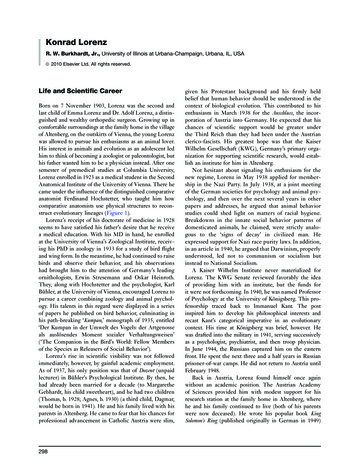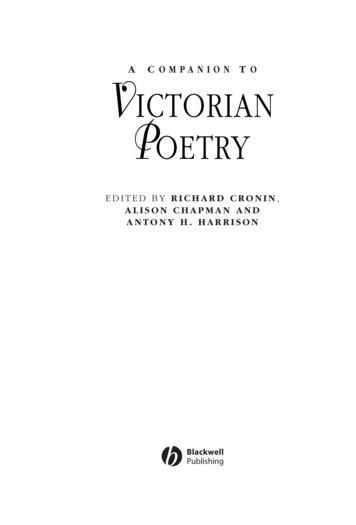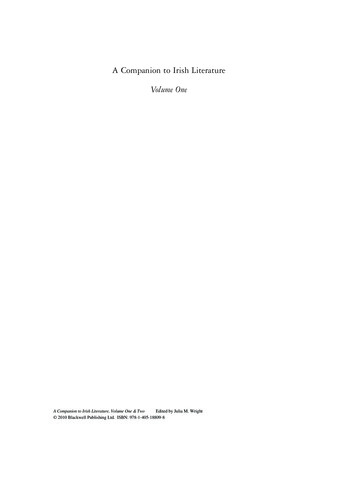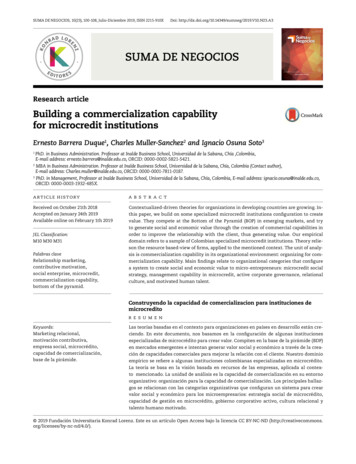
Transcription
Konrad Lorenz 1937The Companion in the Bird's WorldThe Auk, 54(1): 245-273.[OCR by Konrad Lorenz Haus Altenberg – http://klha.at]Seitenumbrüche und -zahlen wie im Original.
K. Lorenz 1937 The Companion in the Bird's World245The Companion in the Bird's WorldIntroductory NoteWhen Dr. Lorenz's paper on the 'Kumpan'1 was published in 1935, it seemed to be such anoriginal and important contribution to our knowledge of the instincts and behavior of birds, thatI was anxious to have a summary of its theses and conclusions appear in the pages of 'The Auk'.Knowing that Dr. Lorenz was conversant with English, I wrote to him, asking if he wouldconsent to prepare such an account of his own work, and he replied that he would be pleased todo so if given sufficient time.Dr. Lorenz's paper was delayed in reaching me from various causes. He found difficultyin summarizing a work which consisted in so large a measure of observational detail, andaccordingly has stressed those subjects of the most theoretical importance; and he added: "Ishall not refrain from using some new observations, and the results of experiments which havecome to my knowledge since the publication of my paper." My function has been mainlyeditorial; and although it has seemed best to condense some parts of the author's manuscript, Itrust that its value has not been impaired.The doctrine of 'releasers,' herein set forth,—or devices for the production of stimuli,which serve as the 'keys' to 'unlock' or release those 'innate perceptory patterns,' characteristicof the species and the individual, and which result in instinctive reactions,—seems at last tooffer a sound and satisfying explanation of that riddle so long embodied in 'the secondarysexual characters of birds,' and one which I believe that Darwin, when struggling with his'Theory of Sexual Selection,' would have welcomed with open arms.—FRANCIS H. HERRICK.THE CONCEPTION OF THE "RELEASER"If we observe a man performing a number of separate actions, each of which has for its objectthe same thing and which, taken together and considered as a functional unit, serve an end ofdefinite survival value to the man himself, we shall not hesitate to infer two things: first, thatthe man, in performing these actions, is conscious of their goal and that it is this very goal thatconstitutes the purpose of all his movements; second, that in performing the several actions ofthe sequence, he is constantly aware of the identity of the object toward which they aredirected. On seeing a similar series of actions executed by some animal, we are prone to cometo the same conclusions, but both would be totally erroneous in case we should have to dowith a series of purely instinctive acts.Much serious harm has been done by confounding the biological end, or survivalvalue of instinctive action, with the purpose pursued by the animal as a subject. I cannot gointo the details of my argument against this widely spread error, but for the purposes of thispaper, suffice it to say that1'DerKumpan in der Umwelt des Vogels (Der Artgenosse als auslösendes Moment sozialerVerhaltungsweisen)' [The Companion in the Bird's World; the fellow-member of the species as areleasing factor of social behavior.] Journ. f. Ornith., vol. 83, pt. 2-3, 1935.
K. Lorenz 1937 The Companion in the Bird's World246I consider instinctive action as 'desired reflex action', meaning that instinctive action, while inno way purposive in itself and quite as rigid as any other reflex as to the coordination ofmovements, yet in its very 'going off' constitutes the purpose of all truly purposive orappetitive behavior ever met within animals. Being appeted, sought or desired, is the onepoint in which instinctive action differs from all other reflex actions. The common reflexes,like unused machines, may lie idle indefinitely, as if waiting for adequate stimulation, withoutin any way inciting the animal to search for such stimulation by purposive behavior, as itcertainly does in case of the instinctive reactions.It is the second of the assumptions mentioned that concerns us more closely; namely,that the animal, in consistently treating one definite object to a series of separate actions, mustthroughout its acting, be aware of the identity of this object. Man, in striving to conquer hisenvironment and to master the problems, which it puts before him by connecting cause andeffect, is confronted with the absolute necessity of conceiving every object he encounters as apermanent unit which remains identical throughout the changes of space and time. Not so theanimal, more especially the lower animal that does not master its environment by insight orlearning but is innately adapted to it by possessing highly differentiated instinctive powers ofresponse. The lower animal very rarely 'solves problems' as an individual, and whenever itdoes so, this is only in an abysmally simple way. As a rule, a lower organism either hassolved a problem as a species by evolving instinctive ways of reacting that fit every single oneof the emergencies that normally occur, or its fails miserably when confronted with a problemfor which it does not possess any suitable instinctive responses. Since the innate coordinationsof movement that we call instinctive actions are not adapted to any goal or end anyhow, itsuffices that every one of them be released, much as in reflexes, by a simple combination ofstimuli, if only this combination is sufficiently characteristic of the biologically 'right'situation; that is, of the one situation in which the performance of the innately coordinatedmovements attains its full survival value. If an instinctive action is directed toward aparticular object, its successful performance is independent of the animal's perceiving thisobject as a 'thing', that is, as a permanent unit in space and time as we would perceive it. Allthat is needed on the part of the animal is the disposition to respond with just that reaction tocertain stimuli characteristic of its particular object. The sea-urchin (Sphaerechinus) possessesa very complicated reaction of combined defense and flight, which is of survival valueexclusively as a means of escaping the sea-urchin's chief enemy, the starfish (Asterias). Thewhole of this highly differentiated sequence of single acts is released by a single chemicalstimulus emanating from the mucus covering the ambulacral tentacles of the
K. Lorenz 1937 The Companion in the Bird's World247starfish. Another good example is that of the biting reaction of the common tick (Ixodes). Thetick will bite, or try to bite, any object possessing the two characters of (1) smelling of butyricacid and (2) having a temperature of approximately 37 degrees centigrade. The releasing ofcomparatively complicated sets of reactions through a very simple combination of stimuli, ischaracteristic of the greater part of all purely instinctive reactions and by no meansexclusively of those of lower animals. The Jackdaw (Coloeus monedula) possesses a veryinteresting reaction of defending any fellow-member of the species in the grip of some bird oranimal of prey. For a long time I have been familiar with the fact that my tame but free-livingJackdaws would furiously attack me if I gripped one of them in my hand, but I was very muchastonished when I inadvertently elicited exactly the same response by carrying a wet, blackbathing-suit in my hand. Subsequent experiments showed that anything glistening black anddangling, carried by any living creature would release the very same reaction in the Jackdaws.Even Jackdaws themselves were subject to attack from their fellows when they happened tocarry nesting material possessing the characteristics just mentioned. In a bird that readilyrecognizes and discriminates fellow-members of the flock, it is rather surprising that theprocess of releasing the social defending reaction so closely resembles that which elicits theresponses of lower organisms as already noticed.An instinctive reaction of survival value, when directed exclusively to a particularobject, may be released as if through a surprisingly small choice among the large number ofstimuli normally emanating from the object. In this circumstance, the reactions of the highestvertebrates do not differ from those of ticks, sea-urchins and the like. The receptory part ofthe animal's reaction responds to a small but characteristic combination of stimuli, very muchin the way in which a highly selective wireless receiving-station is attuned to a particularwave-length. This perceptory correlate to a very definite combination of stimuli has beentermed by William McDougall the 'innate perceptory inlet.' Without knowing this author'sterminology, I used the term 'angeborenes Auslöse-Schema' in German which, respecting thepriority of McDougall's term, I shall compromise by translating 'innate perceptory pattern.'It is an old but fitting metaphor to liken the releasing set of stimuli to the key, and theinnate perceptory pattern to the lock of the instinctive reaction. Even more appropriate, is thesimile of a combination lock that cannot be opened except by a definite series ofmanipulations which, by reason of their general improbability, it is practically impossible tofind by chance. The relation of the particular form of the lock to the key that fits it, or of anyinnate perceptory pattern to the set of stimuli to which it responds, is ever a compromisebetween greatest possible simplicity and
K. Lorenz 1937 The Companion in the Bird's World248greatest possible general improbability. The improbability of the innate perceptory pattern isto guard the instinctive reaction from being released by chance through other than thebiologically 'right' influences. Surprisingly simple though the innate perceptory patterns are inthe three cases cited as examples, they are evidently efficient enough, when natural conditionsare taken for granted, to prevent the 'erroneous' unlocking of the reaction. It is extremelyunlikely that in its natural state the tick is ever misled by its innate perceptory pattern to biteor to try to bite any object that is of no use to it as a potential host. Nor will it often occur inwild life that a Jackdaw erroneously defends a black bathing-suit instead of a fellow Jackdawcaught in the grip of some animal of prey. The species in these cases need not reckon with theexperimenting human, cleverly imitating the key to the instinctive reaction's lock. Butcertainly there are instances in which the very simplicity of innate perceptory patterns mayoffer an opportunity to entrap animals by artificially supplying key stimuli that release certaindefinite actions, as the pike is caught by means of a piece of tin that is drawn through thewater, and supplies the quickly moving silvery reflections which normally release the preyingreactions in this fish. If an instinctive action has for its object any other thing than a fellowmember of the species as, for instance, the natural prey, nesting materials and the like, it isquite clear that the choice of stimuli, effected by means of the innate perceptory pattern, caninclude only such as are inherently characteristic of the object. All that the evolution of thespecies can do, is to adapt the innate perceptory patterns as closely as possible to the preexistent sets of key stimuli. The complication, and with it the highest general improbability ofopening the lock, that is, releasing the reaction, cannot exceed a certain predeterminedboundary drawn by the kind and number of potential key-stimuli emanating from the object.This constitutes a considerable limitation to the scope of object-treatment by purelyinstinctive reactions. There is, however, one special case where this limitation does not existand this is whenever the object of instinctive action is represented by a fellow-member of thespecies. In this case not only the receptory patterns may be specialized to receivepredetermined stimuli, but the issuing of stimuli may be adapted to the special needs ofreleasing social reactions. Not only the receiving, but also the issuing of stimuli is within therange of influence of such factors as may govern the evolution of a species. The pike, to put itvery crudely, is not in a position to attach any special characteristics to the minnow whichmark it as adequate prey and thus prevent the pike from snapping at other things; but the BlueTitmouse may, evolutionally speaking, attach bright yellow marks to the corners of the mouthof the young, or a circle of white feathers around its cloaca, and develop two correspondinginnate perceptory patterns, one of
K. Lorenz 1937 The Companion in the Bird's World249them releasing the feeding reaction on the opening of the young bird's mouth, the other onestarting the reaction of carrying away excretory sacs on the unfolding of the circlet, if white,at the posterior end of the baby bird. The innate perceptory pattern need not, in this case,compromise between simplicity and lock-like general improbability, because the key-stimulicorresponding to it, being sent out by a contrivance especially evolved for that end, may bevery simple and yet of an unsurpassable general improbability. The layman, on seeing theglowing color design of a male Golden Pheasant's plumage, the striking blue and red patternof a young Hawfinch's mouth or the curious 'dance' movements executed by Mallard drakeson occasion of their communal display, is often heard to remark on the 'incredibility' of thesephenomena, thereby correctly acknowledging their extreme general improbability.The means evolved for the sending out of key-stimuli may lie in a bodily character, asa special color design or structure, or in an instinctive action, such as posturing, 'dance'movements and the like. In most cases they are to be found in both, that is, in some instinctiveacts which display color schemes or structures that were evolved exclusively for this end. Allsuch devices for the issuing of releasing stimuli, I have termed releasers (Auslöser),regardless of whether the releasing factor be optical or acoustical, whether an act, a structureor a color.The essential general improbability of all releasers is brought about in a way characteristicand very similar even where they have been evolved independently in very different forms ofanimal life. Throughout the universe it is order that is improbable while disorder, chaos,entropy or whatever one chooses to call it, is what we should expect from the laws ofprobability. I do not think it too far-fetched an explanation to suppose that the strikingorderliness and regularity which so strongly appeals to our sense of beauty in the coloring, thenotes and the display movements of so many animals, especially of birds, has its source intheir nature as releasers and in the general tendency of all releasers to develop in the directionof the more improbable. This would also explain the astonishing rhythm that we meet in verynearly every releasing action. The more or less pure spectral colors which so often appear incolor patterns functioning as releasers, very probably also find their explanation in this way,since the reflexion of one wavelength among the wave-mixture of white light is in itself ratherimprobable, so improbable indeed that color alone may, in some cases, function as a releaser.It is for very much the same reasons that pure colors are applied in all optical signals used byman. It may very well be that the same explanation holds true for the pure and 'beautiful'sounds occurring in bird song, as it quite certainly does for the great number of rhythmicalmovements of limb and body which play so important a part in most releasing actions
K. Lorenz 1937 The Companion in the Bird's World250found in birds. The begging movements of many altricial young birds represent a goodexample of this so that very nearly all the waving movements theoretically possible arerealized in different species. In this they actually resemble all the different waving movementsused in marine signalling by man. To cite but a few instances: up-and-down movements asbegging-releasers have been independently evolved by parrots, gulls, spoonbills and manyothers; swinging the head sideways is found in many finches; young European Orioles(Oriolus, not the icteride bird) perform a rotating movement of the head which has for its axisa line drawn through the upper mandible; young warblers of the genus Sylvia perform anincredibly rapid trembling movement of the head and neck.All these movements and structures, which function as releasers, by their essentialquality of rhythmic regularity, have appealed strongly from time immemorial to the sense ofbeauty in man. It is no wonder that a vast amount of theorizing has been spent on their behalf.Darwin, in his work on 'The Expression of the Emotions in Man and Animals', has indeedcome very close to our conception of releasers, yet it is strange that he attributed so littlesurvival value to their functioning that he could not believe any bodily organ was everevolved for their special use. He states expressly that not a single facial muscle was everdifferentiated in monkeys for the sole end of expressing some emotion. Contrary to this, wemust state that we have good reason to believe that not only muscles, but very complicatedstructures in some species, have been evolved for the purpose of expressing one singleemotion or, to be more precise, of transmitting this emotion to a fellow-member of thespecies. A good example of this is the erectile crest in all night herons, evolved for thepurpose of indicating peacefulness, and comparable in its function to the tail-wagging of adog. Darwin's well-known view about the function of bright colors and striking structures ofmale birds is so far correct, as that there are certainly a considerable number of species inwhich these releasers, in the male, function in eliciting sexual reactions in the female. Yet itwould be an error to generalize this so far as to conclude that all male coloring and all malestructures have been evolved for this function only. Noble and Bradley have shown that in agreat number of reptiles the bright coloring of the male does not evoke any sexual responsesin the female but has its chief function in intimidating other males. What is true of somereptiles has also been regarded as a general rule throughout the animal kingdom. It wasHingston who propounded the theory that all bright coloring encountered in animals, as wellas all peculiar structural designs have been evolved solely for frightening other animals,particularly, but not exclusively, those of the same species. In his opinion even the axillaryhair of man is there to frighten the enemy into non-resistance when the aggressor displays it inraising his fists. There
K. Lorenz 1937 The Companion in the Bird's World251is one indubitable fact underlying both this extreme theory, and the sexual theory, namely,that structures and colors are evolved to influence fellow-members of the species. Yet thisabsolutely correct thought common to both theories was discarded by Wallace, in whoseopinion " the more developed plumage and more vivid colors of the males . . . may be whollydue to their greater vital energy and those general laws which lead to such superiordevelopment even in domestic breeds; but in some cases the need of protection by the female,while incubating, may have suppressed a portion of the ornament which she would otherwisehave attained." To this we must retort that there are a considerable number of birds in which itis the female and not the male that carries 'ornamentation'. Also the very animals in which theornamentation of the males reaches about the highest development it ever attains,—thespiders of the families Attidae and Lycosidae,—cannot well be said to have "more vitalenergy" in the male sex, since the male is much smaller than the female. In these spiders thePeckhams as early as 1889, correctly recognized the releasing function of the male colors andstructures, which, by eliciting specific sexual responses in the female, prevent her fromreacting to the male in an unadaptive way by simply devouring him.Every theory, which, like that of Wallace, leaves to chance the particular regularity ofdetail in all display coloring and structure, commits a serious error against the laws ofprobability. If we refuse to resort to an altogether metaphysical, vitalistic explanation, whichinvolves entelechial factors, it is only by regarding these colored and structural patterns asreleasers that we can hope to find some reason for the regularity and 'beauty' of their design.The very word 'ornamentation' smacks of a metaphysical assumption. That this so-calledornamentation does not necessarily have some sexual significance is exemplified by the manyinstances where its releasing function is of a purely social nature. Nothing can be moreornamental than the crest of night herons or the striking patterns of the wings of many ducks.Yet the former functions as the organ of a peace-making ceremony without any sexualmeaning, while the latter serves as a releaser of the reactions of flying in a flock or of holdingsocially together.Our assumption that most of the bright colors and peculiar structures, or what arecommonly called secondary sexual characters, which we meet with in the bird world, actuallyfunction as releasers of social reactions, receives a convincing confirmation by the fact thatthere are hardly any of them that do not take part in an instinctive ceremony, and are quiteevidently differentiated in such a manner as to be strikingly unfolded by the coordination ofmovements characteristic of the latter. It is hardly an exaggeration if we state that all strikingcolor designs and bizarre structural devices, such as elongated plumes, inflatable pouches,turgescent naked spots and the
K. Lorenz 1937 The Companion in the Bird's World252like, find their exclusive use in some instinctive act representing a releasing ceremony.Supposing I should shoot, in some far country, a bird unknown to science and that this birdhad somewhere on its body a circumscript patch of feathers longer than those of the adjoiningregions, I would confidently assert that this particular species was in possession of somereleasing ceremony in which just that patch of elongated plumes found its use. There areindeed very few structural and color designs that function as releasers automatically, withoutthe aid of special instinctive acts displaying them. The only example of such 'automaticreleasers' at present known to me, is represented by the devices eliciting the flying-in-pursuitreactions in a great many social birds. All of them are color patterns invisible in the sittingbird, but are suddenly and strikingly unfolded at the moment of taking flight. Such patternsare often found in the tail, as in case of the blue-and-yellow design of the Shell Parakeet, thewhite lateral feathers in the tails of tits, shrikes, doves and hosts of other birds. Often thelower back, covered in the sitting bird by the wings, is white or of some striking color, as inthe Bullfinch, the Bean Goose and others. A very high differentiation of this type of automaticreleaser has been attained by numerous species of the anatide order, of which many bearspecial releasing patterns on their wings. Heinroth has made an extensive study of thesereleasers and their function.Lastly, we have to speak of releasing actions, the function of which is not dependenton any structures or colors evolved for their special use. A great many such actions arefamiliar to any student of bird behavior, so that I may confine myself to just one example. Themale Raven has a most striking threatening attitude, in which all the plumage of the bird'shead is tightly depressed, excepting a sharply defined area just above the eye where thefeathers are stiffly erected at right angles to the surface of the skin, so that two ears or hornssuddenly seem to sprout on the angry Raven's front. In a certain ceremony of courtship, themale Raven stretches forward his head and neck horizontally while fluffing the plumage ofthe whole head to the utmost and drawing nictitating membranes over his eyeballs. Thepicture thus presented by the Raven is so totally different in each of these two attitudes that itcan be readily understood that two answering reactions or, more exactly, two different innateperceptory patterns, are released by them in the fellow-member of the species.Releasing actions lacking structural or color designs are of special interest to us incases where closely related species do possess such bodily differentiations, because they oftentend to throw some light upon the phylogenetic development of the structure used in thereleasing action. We know of a considerable number of instances where a certain releasingceremony is common to some closely related species and is executed in all of them in so
K. Lorenz 1937 The Companion in the Bird's World253precisely similar a way that even by studying the single frames of a motion-picture film, notthe slightest difference of movement can be found. Yet it may be that one of these differentspecies does not possess the least bit of structural differentiation to emphasize the opticalstimulation issuing from the movements executed in the ceremony, while a closely relatedspecies has the most striking colors and structures that come into play in the very samecoordination of movement. The Mallard (Anas platyrhynchos), as well as the closely relatedBlack Duck (Anas rubripes), and the two species Anas superciliosa and Anas (Polionetta)poecilorhyncha, have, in the male sex, a communal display ceremony quite alike in all fourspecies. I need not go into the details of movement executed in this reaction, as it suffices tostate that, while A. rubripes and A.superciliosa do not possess structures or colors taking partin this action, A. poecilorhyncha has a bright color pattern on the bill and pure white elbowfeathers, while the brilliant color design of the Mallard drake is well known. In the ceremonyin question, a certain movement of tilting up the posterior part of the body, together with araising of the elbows as strikingly displays the ringlet in the Mallard drake's toil-coverts, as itdoes the white elbows of the poecilorhyncha male. Similarly, in another motion of the sameceremony, consisting of a quick dipping of the bill followed immediately by a stretching-upof head and neck, two characters different in both species are strikingly displayed. In A.poecilorhyncha this down-and-up movement is made eminently conspicuous by the colors onthe bird's bill while in the Mallard the same movement is optically emphasized by thedisappearance and subsequent surprising broadening of the white stripe encircling the drake'sneck. All the conspicuous characters of the male of both species have one thing in common:they are all so placed on the bird's body as to be displayed by the very same movements,which are exactly alike in both species. The night herons of the three genera Nycticorax,Nyctanassa and Cochlearius have exactly the same greeting or peace-ceremony, the functionof which I have likened above to that of a friendly dog's tail-wagging. In this ceremony theupper side of the head is presented to the fellow-member of the species who is to be appeased.All of the three genera possess elongated plumes on the top of their heads that serve toemphasize the movements executed in the ceremony and evidently they were especiallyevolved for this particular end. Yet the ceremony is executed with success also by youngbirds, though still lacking the elongated and conspicuously colored plumes. As a thirdexample of the same principle, I would cite the differentiation of the head-plumage in grebes.In the smallest of European species, the Dabchick, a certain ceremony can be observed inwhich a most singular shape of the head and neck is brought about by depressing the feathersof the neck up to a sharply defined line just below the lower mandible, upward from which
K. Lorenz 1937 The Companion in the Bird's World254the plumage of the head is erected. The sharp boundary between the fluffed and the depressedparts of plumage in the Dabchick is purely functional, no difference in feather length or colorbeing visible in the quiescent or the dead bird. Yet this line, in most other grebes, forms theboundary between the short, plush-like plumage of the neck and the area covered withelongated and brightly colored feathers on the bird's head.In the grebes as well as in the ducks and night herons we find that an instinctiveaction, common to a number of closely related species, has caused some of them to evolvecolors and structures serving to make their movements more conspicuous. The evolution ofstructure and color has gone on independently in the different species, but a certain similarityin its results is caused by the common origin of all bodily differentiations from the source ofone instinctive releasing ceremony. I do not think it either a far-fetched or an incautioushypothesis to assume that in all such cases the releasing ceremony is phylogenetically olderthan the colors and structures used by it. Systematic comparative study of instinctive actionsin birds has shown very clearly that the phyletic age of instinctive reactions is commonly asgreat as that of organs. In very many cases indeed, its special form proved to be a much moreconservative character than that of any organ. Whitman and Heinroth were the first to useinstinctive actions as taxonomic characters and the latter's famous paper on the ethology ofAnatidae has found a very impressive and convincing confirmation in the work of Poll. Thisauthor made an extensive study of the fertility of hybrid birds drawing conclusions therefromon the blood-relationship of the parent species. His results confirmed those attained byHeinroth in literally every point in whic
K. Lorenz 1937 The Companion in the Bird's World 245! The Companion in the Bird's World Introductory Note When Dr. Lorenz's paper on the 'Kumpan'1 was published in 1935, it seemed to be such an original and important contribution to our knowledge of the instincts and behavior of birds, that










